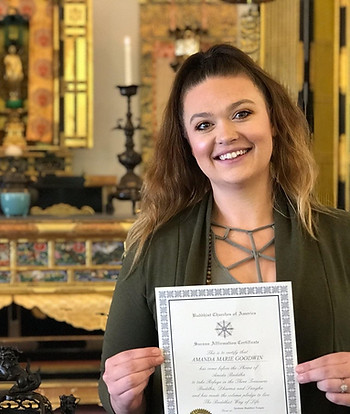
Basics of Buddhism
An Introduction

What is a Buddha?
BUDDHA literally means “awakened one" or "enlightened one." The path of Buddhism is the path to awakening or realization. We awaken to our true self, which is one with all beings and all things.

The Buddha
BUDDHA also refers to the historical Buddha who lived in ancient India over 2,500 years ago. He is known as Gautama Buddha or Shakyamuni Buddha ("Sage of the Shakya"). Gautama is his family name; the Shakya are the clan of people he belonged to in ancient India.
What is Buddhism?
BUDDHISM describes the teachings of the historical Buddha that have been handed down and transmitted throughout the Asian continent and around the world during these past 2,500 years.
Buddhism also means the path to becoming awakened. The source of our suffering and unhappiness in Buddhism is our ego self. We have no one to blame but ourselves whether we live in happiness or misery. Seeing and recognizing the ego self as the cause of our suffering is the beginning of the journey beyond the ego self, to the world of oneness and awakening.
Over the history of Buddhism, various streams or traditions have emerged. These traditions may share common Buddhist practices, and may also differ in how they practice or interpret the teachings.

What makes you a Buddhist?
A BUDDHIST is a traveler on the path to "become" Buddha, an awakened person, and transcend samsara, our world of suffering and ignorance. Buddhism teaches us that until we become awakened, we are like a person lost in the forest, wandering about in delusion. When we pause to search for meaning in our life, or when we find that our life lacks direction, then we are beginning to see that we are lost in delusion.
Realizing that we are lost is the first step to finding real direction in our life.

"What Buddhism teaches me is that we are, indeed, imperfect people, that we do try our best, but we fall short a lot of times. And the key, though, is to understand and not to beat yourself up and to be depressed over this, but rather, know we are embraced within this true reality. There is no judgment. And everybody is going to make it."
Rev. Dr. Takashi Miyaji, speaking with Scott Simon on NPR Weekend Edition Saturday
The Core of the Buddha's Teaching
Resolving life's problems to live a truly happy life
Buddhism challenges us to reflect on our life and look at how we are pursuing happiness, and how we deal with our problems in life. The Buddhist approach is not to run away or escape from our problems, but to embrace the totality of our life experiences.
By facing and accepting the challenges of life, we learn how to see life from beyond our self-centered perspective. This change in perspective frees us from many self-created problems, allowing us to live a truly happy and meaningful life.


"What I loved about entering Buddhism as a beginner is that there were simple quotes and teachings that resonated deeply with me right away. I reflected on them daily. Buddhism took the guesswork out of life and gave me the direction I needed to live happily and healthily.
One of my favorite messages to refer to when I'm having a hard day is from the Dhammapada:
“Our life is shaped by our mind; we become what we think. Suffering follows an evil thought as the wheels of a cart follow the oxen that draws it. Our life is shaped by our mind; we become what we think. Joy follows a pure thought like a shadow that never leaves.”
Before finding Buddhism, my life was run by my emotions. I suffered greatly from anxiety and depression and was constantly, unsuccessfully, trying to find ways to cope. Since finding Buddhism and my wonderful sangha, my life has changed dramatically. Buddhism gave me simple rules for happiness. I learned truths that helped me to reframe my thinking and learn how to live my life with joy and gratitude!"
Amanda Goodwin, receiving her dharma name
Spokane, WA
The Three Marks of Buddhism
Non-Self
When the Buddha awakened to enlightenment under the bodhi tree, he saw beyond his ego self, which melted in oneness with all of life, with all beings, with the entire world around him.
Impermanence
The Buddha taught that all things are constantly changing. This is a simple truth to understand intellectually, but much harder to understand emotionally or spiritually. Impermanence means that we have to let our children grow up and go off to college. Impermanence means we have to accept the loss of a loved one. Impermanence also means that our state of suffering won’t last forever. When we find ourselves in darkness, there are brighter days ahead.
Nirvana
The Buddha’s awakening experience opened his heart and mind to a state of true peace and tranquility, referred to as nirvana. The Mahayana Buddhist tradition sees ultimate oneness between nirvana and this world of samsara. Samsara is nirvana and nirvana is samsara. Nirvana is not a geographic state somewhere “out there,” but is the world around us, if we have the awakened eyes to see it, or the heart and mind to sense it.

The Three Treasures
Fundamental to all schools of Buddhism is to take refuge in the Three Treasures.
Buddha: our teacher
Dharma: the Buddha’s teachings
Sangha: the community of Buddhists
The wonderful Vietnamese Buddhist Master Thich Nhat Hanh teaches that these three treasures are interdependent and cannot exist without each other. The Buddha needs the Sangha to be the Buddha. Without the Dharma to transmit, there is no Buddha or Sangha. Without the Buddha as teacher and guide, a Sangha cannot truly exist and practice. Without the Buddha to expound the teachings, and a Sangha to hear and receive them, there is no Dharma.







